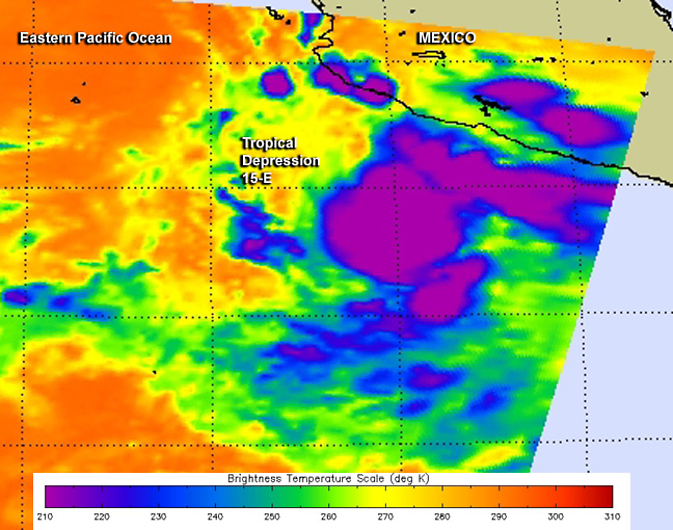NASA Catches Birth of Tropical Storm Odile

This false-colored infrared image from NASA's Aqua satellite captured the birth of Tropical Depression 15-E on September 10 at 8:53 UTC. Image Credit: NASA JPL, Ed Olsen
The Atmospheric Infrared Sounder or AIRS instrument that flies aboard NASA's Aqua satellite captured infrared data on Tropical Depression 15-E on September 10 at 8:53 UTC (4:53 a.m. EDT) when it developed.
The National Hurricane Center named the depression at 5 a.m. EDT, when the center was located near latitude 14.4 north and longitude 102.5 west.
AIRS infrared imagery reads temperature and identified the coldest temperatures in powerful thunderstorms circling the center of the newborn depression. Cloud top temperatures were near 220 kelvin (-63.6F/-53.1C).
By 11 a.m. EDT, the depression strengthened into Tropical Storm Odile. Maximum sustained winds were near 40 mph (65 kph) and Odile was drifting toward the north-northwest near 3 mph (6 kph) and is expected to drift to the north-northwest over the next two days.
Odile was located near 14.9 north latitude and 102.9 west longitude, about 220 miles (350 km) south-southwest of Lazaro Cardenas, Mexico.
The National Hurricane Center noted that on the forecast track, Odile's center will remain offshore of the southwestern coast of Mexico through Thursday night, September 11.
However, Odile is expected to create swells, rip currents and rough surf along the southwestern coast of Mexico over the next day or two.
Rob Gutro NASA's Goddard Space Flight Center
Media Contact
All latest news from the category: Earth Sciences
Earth Sciences (also referred to as Geosciences), which deals with basic issues surrounding our planet, plays a vital role in the area of energy and raw materials supply.
Earth Sciences comprises subjects such as geology, geography, geological informatics, paleontology, mineralogy, petrography, crystallography, geophysics, geodesy, glaciology, cartography, photogrammetry, meteorology and seismology, early-warning systems, earthquake research and polar research.
Newest articles

High-energy-density aqueous battery based on halogen multi-electron transfer
Traditional non-aqueous lithium-ion batteries have a high energy density, but their safety is compromised due to the flammable organic electrolytes they utilize. Aqueous batteries use water as the solvent for…

First-ever combined heart pump and pig kidney transplant
…gives new hope to patient with terminal illness. Surgeons at NYU Langone Health performed the first-ever combined mechanical heart pump and gene-edited pig kidney transplant surgery in a 54-year-old woman…

Biophysics: Testing how well biomarkers work
LMU researchers have developed a method to determine how reliably target proteins can be labeled using super-resolution fluorescence microscopy. Modern microscopy techniques make it possible to examine the inner workings…





















